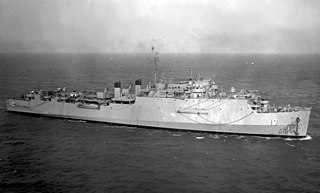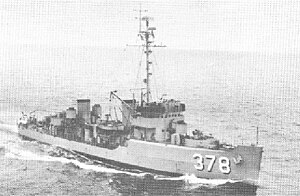
USS Zeal (AM-131) was an Auk-class minesweeper that served in both World War II and during the Korean War. As a steel-hulled fleet minesweeper, she was assigned to support the fleet by removing enemy mines whose purpose was to impede the path of the U.S. Pacific Fleet.

USS Pirate (AM-275) was an Admirable-class minesweeper built for the U.S. Navy during World War II. She was built to clear minefields in offshore waters, and served the Navy in the North Atlantic Ocean and then in the Pacific Ocean. She was returned to active service for the Korean War. During Operation Wonsan she struck a mine and sunk. For her dangerous work, she was awarded four battle stars for her Korean War effort.

USS Reclaimer (ARS-42), was a Bolster-class rescue and salvage ship of the United States Navy. It was the only ship of the US Navy to be named Reclaimer.

USS Pledge (AM-277) was an Admirable-class minesweeper built for the U.S. Navy during World War II. She was built to clear minefields in offshore waters, and served the Navy in the Atlantic Ocean and then was transferred to the North Pacific Ocean. She survived the world war and was awarded one battle star, but, during the Korean War, she struck a mine and was sunk. She received the Presidential Unit Citation for her Korean service.

USS Ruddy (AM-380) was an Auk-class minesweeper acquired by the U.S. Navy for the dangerous task of removing mines from minefields laid in the water to prevent ships from passing. She was the only U.S. Navy ship named for the North American ruddy duck.
USS Symbol (AM-123) was an Auk-class minesweeper acquired by the United States Navy for the dangerous task of removing mines from minefields laid in the water to prevent ships from passing.

USS Toucan (AM-387) was an Auk-class minesweeper acquired by the United States Navy for the dangerous task of removing mines from minefields laid in the water to prevent ships from passing. She was the only U.S. Navy ship named for the toucan, a brightly colored and easily tamed bird of the American tropics, characterized by its large but thin beak.

USS Impeccable (AM-320) was an Auk-class minesweeper built for the United States Navy during World War II. She was originally ordered as HMS Brutus (BAM-7) for the United Kingdom's Royal Navy under Lend-Lease, but was acquired and renamed by the United States Navy before construction began. She was commissioned in 1944 and served in the Pacific before being decommissioned in 1947. After the outbreak of hostilities in Korea, Impeccable was recommissioned in 1952 and served off Korea through 1952. She was decommissioned for the final time in October 1955 and placed in reserve. She was sold for scrapping in 1974.

USS Shoveler (AM-382) was an Auk-class minesweeper acquired by the U.S. Navy for the dangerous task of removing mines from minefields laid in the water to prevent ships from passing.

USS Gladiator (AM-319) was an Auk-class minesweeper acquired by the U.S. Navy for the dangerous task of removing mines from minefields laid in the water to prevent ships from passing.

The second USS Ardent (AM-340) was a Auk-class minesweeper in the United States Navy.

USS Chief (AM-315) was an Auk-class minesweeper acquired by the United States Navy for the dangerous task of removing mines from minefields laid in the water to prevent ships from passing, and named after the word "chief," the head or leader of a group.

USS Merganser (AMS-26/AMCU-47/MHC-47) was a YMS-1-class minesweeper of the YMS-135 subclass built for the United States Navy during World War II.

USS Waxbill (MHC-50/AMCU-50/AMS-39/YMS-479/PCS-1456) was a YMS-1-class minesweeper of the YMS-446 subclass acquired by the U.S. Navy for the task of removing mines placed in the water to prevent ships from passing.

USS Kite was a YMS-1-class minesweeper of the YMS-135 subclass built for the United States Navy during World War II.
USS Mainstay (AM-261) was an Admirable-class minesweeper built for the U.S. Navy during World War II. She was built to clear minefields in offshore waters, and served the Navy in the Atlantic Ocean and the Pacific Ocean.

USS Lipan (AT-85) was a Navajo-class fleet tug constructed for the United States Navy during World War II. Her purpose was to aid ships, usually by towing, on the high seas or in combat or post-combat areas, plus "other duties as assigned." She served in the Pacific Ocean during World War II and the Korean War. She was awarded two battle stars for World War II and four battle stars for the Korean War.

USS Grapple (ARS-7) is a Diver-class rescue and salvage ship commissioned in the United States Navy from 1943 to 1946 and from 1951 to 1977. In 1977, she was sold to Taiwan and was renamed ROCS Da Hu (ARS-552).

USS Grasp (ARS-24) was a Diver-class rescue and salvage ship commissioned by the U.S. Navy during World War II. Her task was to come to the aid of stricken vessels.

USS Comstock (LSD-19) was a Casa Grande-class dock landing ship of the United States Navy. She was the first navy ship named in honor of the Comstock Lode in Nevada, discovered in 1859, which was one of the richest deposits of precious metals known in the world.















